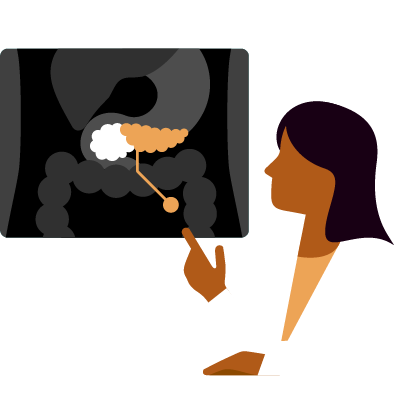The Diabetes and Pancreatic Cancer Connection

The pancreas has many functions, and one of its most important roles is the regulation of blood sugar.
To reduce blood sugar levels, the pancreas produces insulin. To increase blood sugar, the pancreas produces glucagon. But far too often, the complex mechanisms that keep this finely tuned balancing act functioning perfectly can go awry. The result: diabetes, a chronic condition that has been called a 21st century epidemic, affecting about 9 percent of the U.S. population.
There’s no doubt diabetes is a serious condition increasing the risk of heart disease, stroke, vascular and kidney problems, vision loss, and premature death. But diabetes can also increase the risk of pancreatic cancer. And, by itself, diabetes can be a symptom of the disease.
“When talking about diabetes, the potential pancreatic cancer connection is often left out of the conversation,” explains Dr. Suresh Chari, professor of medicine at MD Anderson Cancer Center, Houston, Texas, (formerly at the Mayo Clinic). In 2005, Chari and colleagues showed that new-onset diabetes can be an early symptom of pancreatic cancer.
To be clear, diabetes is an all-too-common diagnosis worldwide. Pancreatic cancer is rare, but incidence is rising. “Not every patient with diabetes is going to develop pancreatic cancer, but doctors and patients needs to be made more aware that new-onset diabetes or sudden worsening of preexisting diabetes can be a harbinger of pancreatic cancer,” Chari says. “It’s something we’ve known for a while.”
Several New Studies Offer New Clues for Potential Earlier Detection
Indeed, the relationship between diabetes and pancreatic cancer has been known for more than a century. “But we still don’t fully understand it,” Chari says. “There are groups throughout the world looking at the relationship but there are still a lot of questions to be answered and more questions we need to ask. Nonetheless, this is an area of research that could potentially lead to earlier detection of pancreatic cancer. That’s vital if we are going to improve long-term survival.”
Blood Sugar Elevation and Tumor Size
In one study published in the journal Gastroenterology, researchers looked at two groups of patients (those with pancreatic cancer and those without, who were age- and gender-matched to the pancreatic cancer group.) Their analysis showed that pancreatic cancer patients can develop elevated blood sugar (blood glucose) levels anywhere from 30 to 36 months before the diagnosis of pancreas cancer. “What we know is that in patients that have had diabetes for many years, the diabetes came first. But when it’s a new-onset diabetes that is then followed by a diagnosis of pancreatic cancer, diabetes is a symptom of the cancer. That means that we could have an opportunity to intervene earlier.”
In the same study, the researchers looked at a separate group of 600 patients prior to surgical removal of their pancreatic tumors. They grouped patients by tumor volume and found those with smaller tumors had lower blood sugars than those with larger tumors. That means blood glucose levels rise in relationship to the size of the tumor, says Chari, a co-author of the study. “Pancreatic cancer is a disease that desperately needs earlier detection, and there has always been a school of thought that it develops too quickly and spreads too rapidly for early detection to be feasible,” Chari says. “That isn’t necessarily the case.”
Developing an Algorithm to Determine Risk
In another study published in Gastroenterology, researchers developed an early-detection model they validated for honing in on diabetic patients who may be at the highest risk of developing pancreatic cancer. For patients with new-onset diabetes who are older than 50, the risk of developing pancreatic cancer is approximately 1 percent within three years. “It’s a small risk but it’s still about eight times that of the general population,” says Chari, a study co-author. “That’s why it’s important we know who these people are.”
The model, called END-PAC, which stands for Enriching New-Onset Diabetes for Pancreatic Cancer, is based on three easily accessed metabolic factors: weight change, a change in blood glucose, and age at onset of diabetes as determined by glycemia, or the presence of glucose found in a patient’s blood. The results of the retrospective study showed 80 percent sensitivity and 85 percent specificity for identifying pancreatic cancer in those with an END-PAC score of at least 3 in both the discovery and validation cohorts. Those with an END-PAC score of at least 3 had a 4.4-fold higher prevalence rate of pancreatic cancer than those with new-onset diabetes. END-PAC scores no higher than 0 indicate a very low risk of pancreatic cancer.
Although an independent prospective study is needed to further validate the model, the algorithm is “very promising,” explains Chari. “I believe patients who have a high blood sugar, especially one that has been controlled previously, and a high END-PAC score should be tested for pancreatic cancer.”
Understanding the Diabetes Connection
Although more research needs to done, earlier detection will happen, Chari says. He is currently working on a multi-site trial involving 10,000 participants with new-onset diabetes, who may have a higher-than-average chance of developing pancreatic cancer. Participants will have blood tests every six months. Researchers hope to identify biomarkers that could potentially be used in new screening methods. “If we could identify those individuals who are at the highest risk of pancreatic cancer and get them into appropriate screening programs, we can improve survival,” he explains, emphasizing that people with diabetes shouldn’t panic. “Just be aware,” he adds. “People and their doctors need to be alert and the research community needs to come up with more answers. Incredible progress is being made in pancreatic cancer, but it’s still one of the most deadly of diseases. We need to change that.”
Although research is ongoing, here is some information diabetes patients should know:
- There are well-established risk factors for pancreatic cancer, including: family history and certain genetic syndromes, smoking, chronic pancreatitis, obesity, and diabetes. If you’ve had diabetes for a while, it is considered a modest risk factor, increasing risk to about two-fold, Chari says.
- If you were newly diagnosed with diabetes after age 50, you are eight times as likely to be diagnosed with pancreatic cancer one to three years after the diabetes diagnosis. It’s also important to note that some cases of new-onset diabetes could potentially be a form of the disease called type 3c diabetes. “This form is caused by something going on in the pancreas, like a malignancy,” Chari says, noting that one of the defining characteristics of this form of diabetes is weight loss, in contrast to type 2 where subjects often gain weight while developing diabetes.






